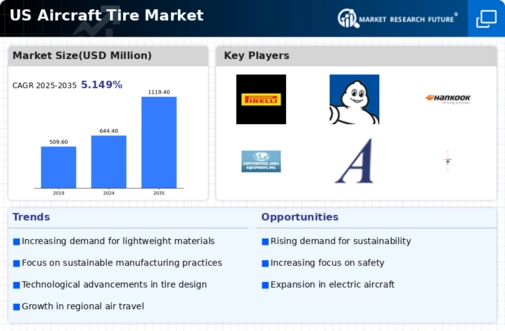Increased Air Travel Demand
The aircraft tire market experiences a notable boost due to the rising demand for air travel in the United States. As more passengers opt for air travel, airlines are compelled to expand their fleets, thereby increasing the need for aircraft tires. In 2025, the commercial aviation sector is projected to grow by approximately 5% annually, leading to a heightened requirement for tires that can withstand increased operational demands. This growth in air travel not only drives the production of new aircraft but also necessitates the replacement of worn-out tires, further propelling the aircraft tire market. Additionally, the need for enhanced safety and performance in tires aligns with the industry's focus on reliability, which is crucial for maintaining operational efficiency and passenger safety.
Growth of Cargo and Freight Aviation
The growth of cargo and freight aviation in the United States positively influences the aircraft tire market. As e-commerce continues to expand, the demand for air freight services is on the rise, leading to an increase in cargo aircraft operations. In 2025, the air cargo sector is projected to grow by around 6% annually, necessitating a corresponding increase in the production of aircraft tires designed for cargo planes. This growth presents opportunities for manufacturers to develop specialized tires that can handle the unique demands of cargo operations, such as higher load capacities and durability. Consequently, the expansion of the cargo aviation sector is likely to drive innovation and investment in the aircraft tire market.
Regulatory Compliance and Safety Standards
The aircraft tire market is significantly influenced by stringent regulatory compliance and safety standards imposed by aviation authorities in the United States. These regulations mandate that tires meet specific performance criteria, including durability, load capacity, and resistance to wear. As a result, manufacturers are compelled to innovate and enhance their products to comply with these standards. In 2025, it is estimated that compliance-related costs could account for up to 15% of the total production expenses in the aircraft tire market. This focus on safety not only ensures the reliability of aircraft operations but also fosters consumer confidence, thereby driving demand for high-quality tires that meet or exceed regulatory requirements.
Technological Innovations in Tire Manufacturing
Technological advancements in tire manufacturing are reshaping the aircraft tire market. Innovations such as advanced materials, improved tread designs, and enhanced manufacturing processes contribute to the production of tires that offer superior performance and longevity. In 2025, the introduction of lightweight composite materials is expected to reduce tire weight by approximately 10%, which can lead to improved fuel efficiency for aircraft. Furthermore, the integration of smart technologies into tire design allows for real-time monitoring of tire conditions, enhancing safety and performance. These innovations not only cater to the evolving needs of airlines but also align with the industry's push for more efficient and sustainable operations.
Focus on Cost Efficiency and Lifecycle Management
Cost efficiency and lifecycle management are becoming increasingly critical in the aircraft tire market. Airlines are seeking ways to reduce operational costs while maximizing the lifespan of their tires. In 2025, it is anticipated that airlines will invest approximately 20% of their maintenance budgets on tire management strategies, including regular inspections and timely replacements. This focus on lifecycle management encourages manufacturers to produce tires that not only offer better performance but also have extended service lives. Additionally, advancements in tire recycling and retreading technologies are likely to play a pivotal role in enhancing cost efficiency, thereby influencing purchasing decisions in the aircraft tire market.

















Leave a Comment